PSY3309
Behavioral Neuroscience


Dr. Smith
Florida Southern College
Psychology and the Natural World
Dorsal View
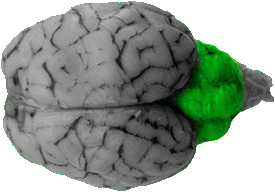


Cerebellum
The cerebellum is a large structure that can be seen covering the hindbrain on this view.
Frontal Lobe
The frontal lobe is comprised of approximately one third of the cerebral cortex from the dorsal view.Its caudal boundary is marked by the cruciate fissure, which separates the frontal lobe from the parietal lobe in the sheep brain. In a human brain the frontal lobe extends much further back to a boundary called the central sulcus.The primary function of the frontal lobe is for voluntary movement,but its activity has been highly correlated with higher intellectual behaviors.
Longitudinal Fissure
The longitudinal fissure separates the left and right cerebral cortex hemispheres. It runs from a rostral to caudal direction along the entire mid line of the cerebral cortex.

Occipital Lobe
The occipital lobe is the caudal portion of the cerebral cortex. Its primary function is to process vision.
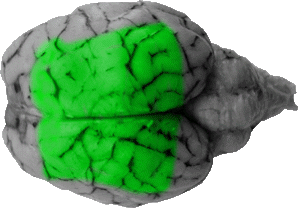
Parietal Lobe
The parietal lobe consists of all gyri between the frontal lobe (separated by the cruciate fissure) and the occipital lobe. Its primary function is to process skin sensations but it is also associated with spacial, body awareness.

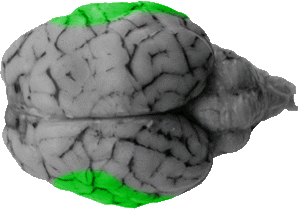
Spinal Cord
The spinal cord is the caudal portion of the brain that comes off the back of the cerebellum. This structure is how somatosensory and voluntary motor information can travel between brain and body.
Temporal Lobe
The temporal lobe is laterally separated from the
parietal lobe by the suprasylvian sulcus and this can be barely seen on the dorsal view. Its primary function is to process hearing but has also been associated with emotional behaviors as well as declarative memory retrieval.
Ventral View
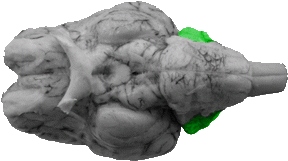
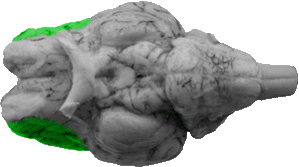



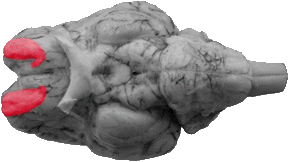

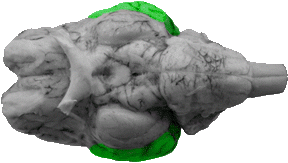
Cerebellum
On the ventral view much of the cerebellum is hidden. The only areas that can be seen on this view are the corpus cerebelli and the flocculus.
Frontal Lobe
Much of the frontal lobe cannot be seen on the ventral view. However, the inferior frontal gyrus can be found lateral (and dorsal) to the rhinal fissure at the very front of the brain.
Insula
The insula is a small area of matter that is surrounded by the anterior and posterior rami of the lateral fissure, and the rhinal fissure. This area is now considered to be a major lobe of cortex whose function involves the mediation of taste.
Medulla
The medulla is located directly in front of the spinal cord (with which it fuses). It is literally a vital center for the body, which means that it regulates autonomic ability (e.g., having a heartbeat) and reflexes involving the face, mouth, and throat (e.g., coughing, vomiting).
Occipital Lobe
The most caudal portion of the occipital lobe can be seen on the ventral view in which it's separated from the hippocampal gyrus by means of the caudal part of the rhinal fissure.
Olfactory Bulb
The olfactory bulb is an oval shaped structure located towards the rostral part of the brain. It is lateral to the medial olfactory gyrus and is medial to the rhinal fissure. The olfactory bulb directly receives sensory input from the nasal cavity (via the olfactory nerves), and it is critical for the processing of smell. It should be noted that a human olfactory bulb is considerably smaller than what is seen in the sheep.
Pons
The pons is a large rectangular elevation that is caudal to the cerebral peduncles and the interpeduncular fossa. It has on each side a lateral projection of the pons (known as the brachium pontis, or middle cerebellar peduncle) that projects into the cerebellum.
Temporal Lobe
In higher level mammals, the temporal lobe is separated from the frontal lobe by the lateral fissure. In the sheep, branches of the lateral fissure separate the insula from the temporal lobe as well.
Lateral View
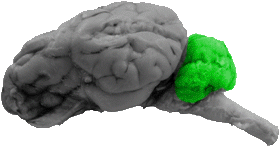

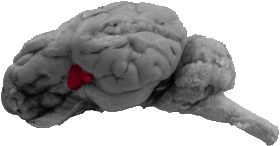



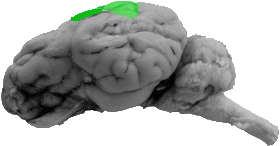

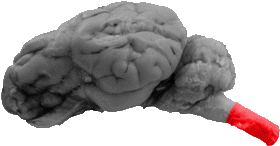
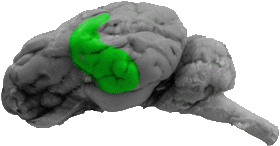
Cerebellum
From the lateral view the following structures can be seen, the posterior lobe, the corpus cerebelli, and the flocculus.
Frontal Lobe
The frontal lobe is the rostral one third of the cerebral cortex.
Insula
The insula is bound by all parts of the lateral fissure as well as by the rhinal fissure.
Medulla
The medulla is located directly in front of the spinal cord (with which it fuses). It is literally a vital center for the body, which means that it regulates autonomic ability (e.g., having a heartbeat) and reflexes involving the face, mouth, and throat (e.g., coughing, vomiting).
Occipital Lobe
The occipital lobe constitutes the back portion of the cerebral cortex.
Olfactory Bulb
The olfactory bulb can be seen directly below the very front of the rhinal fissure.
Parietal Lobe
The parietal lobe is the dorsal, middle portion of the cerebral cortex.
Pons
The pons is an enlarged structure that is in front of the medulla, and the cerebellum is directly above the medulla (and slightly behind the pons).
Spinal Cord
The spinal cord serves as the caudal portion of this view.
Temporal Lobe
The temporal lobe constitutes most of the side portion of the cerebral cortex.
Medial View








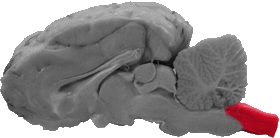
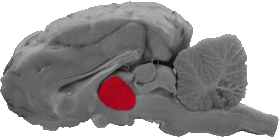
Cerebellum
From the sagittal view the cerebellum can be divided into an anterior lobe, a posterior lobe, a nodule, and the arbor vitae (the white matter).
Corpus Callosum
The corpus callosum is a massive bundle of fibers whose cross section can be seen on the sagittal section. It can be divided into four parts: the rostrum, the genu, the main portion, and the splenium.
Frontal Lobe
The very front of the brain.
Hypothalamus
The hypothalamus serves as the ventral wall on each side of the brain below the thalamus.
Medulla
Following the spinal cord (from the back to the front), the medulla is apparent.
Occipital Lobe
Very back of cortex, between the parietal lobe and cerebellum.
Parietal Lobe
Very top of the brain, past the frontal lobe.
Pons
Fused in front of the medulla.
Spinal Cord
The spinal cord is the most caudal region of the brain in the sagittal view.
Thalamus
The thalamus is a large rounded mass that is dead center in the brain.